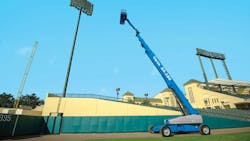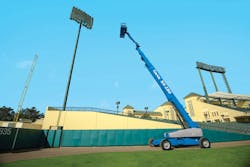Select it Right
Workplace Analysis
When selecting the most appropriate AWP equipment, a workplace analysis must be conducted to determine how the work is going to be safely accomplished. The workplace analysis should address the following:
Required Elevation
Questions to ask regarding elevation include:
- How high does the worker need to reach?What is the task that needs to be performed?
- How close does the worker need to be to the work being performed?
- The height required will help in selecting the specific size range of AWP equipment. Be aware that the height of AWP equipment can be expressed in two common ways — platform height and working height.
- Platform height is the vertical distance from the surface upon which the AWP equipment is being supported to the floor of the platform.
- Working height is the reach of a worker — generally six feet — added to the platform height.
Required Horizontal Outreach
Questions to ask regarding horizontal outreach include:
- How close can the worker get to the work that needs to be performed?
- What is the height of the object that needs to be reached over to access the work?
- What horizontal outreach and height is required to safely perform the work?
- Are there any obstacles on the ground that will determine where to position the AWP equipment?
Note: The manufacturers’ specification sheets define the platform’s horizontal reach from the center of the rotation of the machine, not the side of the machine. Some add two feet for personnel reach, others do not.
After the height and outreach required for the work are determined, the most appropriate type of AWP equipment can be defined. For instance:
- If the worker is directly beneath or beside the task to be performed, a scissorlift or vertical lift may be most appropriate. Scissorlifts with an extension deck also may be an option if there are limited reach requirements.
- If the worker must reach out to perform the work, a boomlift is probably more suitable.
- In some cases where a “straight shot” reach cannot be achieved, an articulated boomlift may be most appropriate, providing “up-and-over” reach. This is typical when an elevated obstacle is in the way of the work such as when the work is above a lower roof or balcony.
Remember that when considering AWP equipment, a review of the manufacturer’s specification sheet will define the horizontal outreach allowed based on the configuration of the AWP equipment.
Required Capacity
Questions to ask regarding capacity include:
- How many people need to be lifted?
- The primary purpose of AWP equipment is to raise personnel and tools to temporarily work at height. AWP equipment have a specific capacity rating with the number of allowable people who can be on the platform.
- AWP equipment have a specifically designed carrying capacity or rated work load (RWL) specified by the manufacturer. This is a total work load, including personnel, tools and materials. However, you cannot add more personnel beyond the rated number of people, even if their combined weight is less than the RWL.
- What is required to be on the platform in addition to personnel? Are specific tools or materials required on the AWP equipment?
- This will require sufficient rated capacity and the size of the platform to lift all items, in addition to allowable personnel on the platform.
- Only properly secured tools and materials, which are evenly distributed and can be safely handled by workers from the platform, are allowed.
- If the AWP equipment’s allowable RWL cannot support the required loads referenced, the task must be reassessed.
Suitable Support and Driving Conditions
Questions to ask regarding suitable (i.e., slope, level, irregular, uneven) and adequate (i.e., capacity) support conditions include:
- At what stage in the job will the AWP equipment be needed and what will the ground conditions be like at that stage (i.e., loose fill; proximity to excavations; rough, prepared, paved, poured slab; and/or finished surface)?
- What is the terrain in which the machine will be both traveling and elevating?
- Is it level, sloped, uneven, rough, frozen or wet?
- Are there obstacles such as debris, drop-offs, holes or depressions?
The consideration of ground conditions prompts further investigation such as:
- Are all areas capable of supporting the maximum floor/ground-loading imposed by the AWP equipment, including the load in the platform as defined by the AWP equipment manufacturer?
- Are there any underground utilities, vaults, trenches, drains, manholes or inspection covers that need to be avoided?
- Are there excavations, basements or cellars that may affect the stability of the AWP equipment?
- Are there other areas the AWP equipment should not be driven on while elevated?
- Will the weight of the AWP equipment, plus the RWL, impose any potential damage to the floor or ground surface?
- What is the maximum ground-bearing capacity at the work area, along the route, and to and from the work?
- What terrain and gradient will the AWP equipment have to cross, climb or descend to get to the work position? Is the visibility, separation from personnel and other equipment adequate so the AWP equipment is able to maneuver safely?
- Are there overhead obstructions or electrically energized conductors that will need to be avoided?
- What is the minimum approach distance to work-area-related electrically energized conductors [reference CFR 1910.333(c) minimum approach distance (MAD)]?
- Is the potential presence of unauthorized personnel a concern that will need to be addressed?
- Are there any site-specific issues?
- Are there specific recommendations required by the AWP equipment’s manufacturer in the operator’s manual?
Note: Always refer to the manufacturer’s operator’s manual to identify the maximum ground pressure imposed by the AWP equipment as it varies based on the configuration of use.
Hazardous Atmosphere Conditions
Questions to ask regarding hazardous atmosphere conditions include:
- Has a qualified person determined if any location contains, or has the potential to contain, an explosive or flammable atmosphere as defined by ANSI/NFPA for powered industrial trucks, including type designations, areas of use, maintenance and operation?
- Are operators trained, as necessary, to recognize potentially hazardous atmosphere locations that may become evident during operation?
Work Located Inside
Questions regarding the power source required for the work area include:
- Are emissions from an internal combustion engine a concern for the workplace?
- Are there any flammable materials in the work area?
Questions regarding proper lighting:
- Is there adequate lighting?
- Can the operator see overhead while stationary and while driving?
Questions regarding adequate ground support:
- What is the acceptable floor load?
- What does the AWP equipment weigh?
- What is the maximum floor-loading pressure of the AWP equipment?
- What is the possibility of damaging the surface it is driving on?
Question regarding other activities taking place inside the facility:
- What other types of equipment are working in the same area?
To read the entire Statement of Best Practices for Workplace Risk Assessment and Aerial Work Platform Equipment, visit: http://www.ipaf.org/fileadmin/user_upload/documents/us/Risk_Assessment_and_AWP_Selection.pdf.

